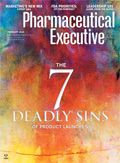- Sustainability
- DE&I
- Pandemic
- Finance
- Legal
- Technology
- Regulatory
- Global
- Pricing
- Strategy
- R&D/Clinical Trials
- Opinion
- Executive Roundtable
- Sales & Marketing
- Executive Profiles
- Leadership
- Market Access
- Patient Engagement
- Supply Chain
- Industry Trends
Creativity Needed in Drug Pricing, Promotion
Pharmaceutical Executive
Pressure mounts for new drug payment models and greater clarity on economic evidence.
The uproar over the cost of new medicines for treating millions of hepatitis C virus (HCV) patients has generated a genuine price war, as the approval of alternative therapies has upped the negotiating clout of pharmacy benefit managers (PBMs) and health plans, pressuring manufacturers to offer deeper discounts in exchange for exclusive formulary placement. The battle over drug pricing also is spurring interest in devising payment strategies that can support biopharmaceutical innovation without busting the nation's healthcare system. There has been some success with "value-based" and "risk-based" payment programs, and now analysts are talking about annuity models that spread payments for medicines over longer time periods.

Jill Wechsler
Insurers are leading the attack on drug pricing, linking rising outlays for medicines to higher premiums. We "cannot sustain blank checks" to pharma companies looking to charge whatever they want, asserted Karen Ignagni, president of America's Health Insurance Plans (AHIP), at the FDA/CMS Summit in December. She noted that drugs still may be a relatively small portion of healthcare spending, but that outlays are growing fast.
One factor is soaring prices for specialty drugs. Amgen's new treatment for a rare leukemia just came out with a $178,000 treatment cost, beating the $120,000 price for Bristol-Myers Squibb's Yervoy for melanoma. New gene therapies carry $1 million price tags. But only about 1,000 Americans may be eligible for the Amgen therapy, while new HCV drugs are indicated for millions of patients, bringing total outlays way beyond those for cancer and rare disease therapies. Payers similarly are holding back on approving reimbursement for new, more expensive anti-obesity drugs that may be prescribed for years, and they're worried about more costly diabetes and heart medicines.

More competition
Ignagni urged FDA approval of more new drugs, including biosimilars, to promote price competition, and that strategy is bearing fruit. PBM Express Scripts recently announced a landmark deal for a discounted price on AbbVie's new HCV treatment Viekira Pak in exchange for exclusive formulary listing. CVS Health followed with an agreement to cover only Gilead's Harvoni and Sovaldi. Some doctors are unhappy at being limited to one new HCV therapy, but other practitioners seem pleased by the prospect that more patients may receive treatment earlier. Cigna said it's monitoring health outcomes of patients treated with Sovaldi and is finding 90% response rates, as seen in Gilead test data.
PBMs seek to improve their negotiating position further by cutting formularies. Last year Express Scripts and CVS dropped dozens of products off their lists, creating less expensive plans with limited formularies and high deductibles, which many employers find attractive, particularly for low-wage workers. And high coinsurance for specialty drugs has become the norm: analysis by Avalere Health reports that many "bronze" and "silver" exchange plans are charging 30% or more coinsurance for specialty medications, primarily to keep premiums low.
Pharma companies fear that plans with high coinsurance and restricted formularies discriminate against sicker patients, particularly those plans that put all AIDS therapies and many cancer meds in the top formulary tier. Manufacturers are working with patient advocates and providers to promote comprehensive drug benefits in exchange plans, as seen in comments recently filed by the National Health Council. The group urged greater transparency in formulary descriptions, curbs on limited coverage lists, and more effective "exceptions" processes for obtaining unlisted medicines.
Savings strategies
At the same time, industry is working with payers to explore innovative reimbursement strategies. At the December Summit, Mark McClellan of the Brookings Institution cited "mortgage models" to pay for drugs. Ignagni noted that plans are using bundled payment arrangements and accountable care organizations to achieve savings in cancer care. Avalere CEO Dan Mendelson is looking at programs that spread out the cost of drug treatment over several months and in ways to deal with $6,000 out-of-pocket annual maximums. He also advises pharma companies to align patient assistance programs with plans' interest in adherence and compliance to build access and coverage.

Communicating with payers
CareFirst of Maryland is testing a program that waives cost-sharing on specific drugs for certain high-cost patients that join a care management plan, reports CareFirst executive vice president Jonathan Blum, former director of Medicare. Patients signing up for coverage through exchanges, Blum noted, tend to be more dependent on high-cost specialty drugs, making it important to integrate drug benefits with cost-of-care models.
But the trend is toward more restricted formularies to manage costs in both private and public plans. And without the option of a specialty tier, PBMs claim that some costly drugs might not get any coverage at all, where not specifically required by law. Insurers generally are more comfortable negotiating discounts and rebates, especially for plans sold through exchanges where beneficiary turnover may be high. And plans appear more willing to test new payment models in Medicare Advantage plans that tend to hold members longer.
The feds were shot down last year in floating proposals to reduce costs in the Medicare Part D program by moderating requirements to cover all drugs in certain "protected classes." Those changes will re-emerge and are likely to gain more support in the next round as more consumers agree to accept less drug choices for lower prices.
Jill Wechsler is Pharmaceutical Executive's Washington correspondent. She can be reached at jwechsler@advanstar.com.

